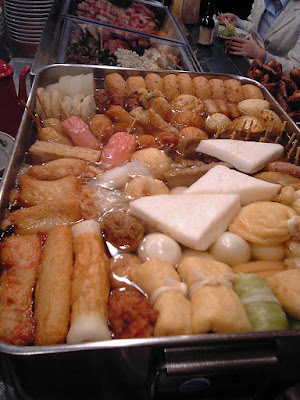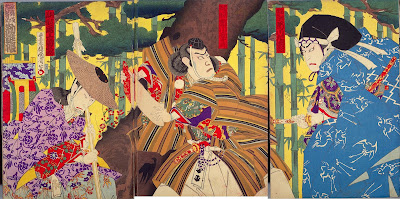Wagashi is a general term for traditional Japanese confectionery. The term was coined in modern times to differentiate Japanese sweets eaten with green tea from Western-type cakes.
Although already the prehistoric Jomon people ate cookies made from chestnut powder, wagashi as we know them are of more recent origin.
[Sakura-mochi, typical wagashi]
In fact, there were five stimuli, through the course of history:
1. Chinese confections in the Nara period (brought back by Japanese scholars studying in China);
2. Zen Buddhism (wagashi were part of the vegetarian diet of priests);
3. Contact with Spain and Portugal in the 16th c., which led to the introduction of Namban-gashi as
kasutera.
4. Also in the 16th c., the introduction of sugar (before that, sweet bean paste (
an) and dried fruits like persimmon were used for sweetening). In the Edo-period, Amami-Oshima became the production center of sugar cane. Further, a new type of sugar,
wasanbon was perfected in this period and is still used exclusively to make wagashi.
5. The fifth and biggest stimulus was the development and popularization of the tea ceremony during the Edo period.
In the late 17th c., the first
kashiya, confectionery shops appeared in Kyoto, Osaka and Edo (Tokyo). Regional varieties of wagashi also developed.
Japanese confectionery is very different from its Western counterpart in the following respects:
- Japanese confectionery contains no butter, baking powder or yeast
- Japanese confectionery is not baked
- Japanese confectionery originally contained no sugar
- The main ingredient of Japanese confectionery is an, a paste made from red azuki beans and other ingredients
- The other main ingredients are rice flour and mochi (glutinous rice cakes)
Wagashi are made from natural, plant-based ingredients. Oil or dairy products are not used and there are no strong aromas (and of course, no artificial flavoring). The most distinctive ingredient (often used in one way or another) is a sweet paste (
an) made from red azuki beans, which was first developed in the Kamakura period. Wheat flour and glutinous rice are also often used.
[Wagashi in the shape of ayu, sweetfish, are sold in early summer]
Like all things Wa, wagashi are by their shape and color attuned to the seasons – some types are only sold at certain times of the year. The names of wagashi can be fanciful and sometimes contain allusions to classical literature. Certain wagashi are part of the formal tea ceremony, even more types are eaten informally, but always with green tea. Wagashi are a popular gift among the Japanese and when visiting a Japanese family, one can not go wrong when bringing a nicely packed box of wagashi.
Wagashi are sometimes divided into several types as
namagashi (“moist” i.e. uncooked confections),
higashi (dry confections) and
yakigashi (grilled confections), but as most types belong to the category of namagashi, this division is not very useful. And there are also new types as “chilled wagashi!” Note that usually wagashi can not be kept very long.
Types
The most popular Japanese confection is probably the
manju, a sort of dumpling made from wheat flour, filled with red bean paste and steamed. There are countless types of manju, for example with a green tea taste or different fillings as chestnuts, and travelers will find them to take home in onsen towns and other tourist destinations.
Also
yokan are very popular. This is a jellied dessert made of red bean paste, sugar and kanten (agar-agar), sold in block form and eaten in slices. There are various types: neri-yokan, which is sturdier, and mizu-yokan, which contains more water and is often eaten chilled in summer. Yokan contain much sugar and can be kept longer than other wagashi.
[Mizu-yokan packed in a bamboo container]
Daifuku ("great luck"), is a popular cake consisting of a quantity of red bean paste wrapped in a mochi, a layer of glutinous rice.
Sakuramochi are a special type of Daifuku and are wrapped in pickled cherry leaves. Traditionally they were eaten at the Doll’s Festival on March 3.
Chimaki are soft rice dumplings wrapped in bamboo leaves. They were eaten especially on the Boy’s Festival on May 5.
Dango are small rice-flour dumplings served three to four on a skewer and eaten coated with bean paste. They can also be grilled on a wire rack and then coated with a sticky sauce. In 1998, dango experienced a surge of popularity when the song Dango san kyodai (“three dango brothers”) was released – dango being a wordplay on Tango.
Ohagi are steamed balls of glutinous rice wrapped in red bean paste (so the reverse of Daifuku) or kinako (soy bean powder). Traditionally, they are made during the Spring and Autumn Equinoxes. The term ohagi derives from the autumn flower hagi (bush clover), while in spring the confection is called botamochi, after the spring flower botan (peony).
Monaka is a thin, crisp wafer filled with red bean paste, often round on shape.
Kasutera is a typical Namban-gashi, learned from the Portuguese who came to Nagasaki in the 16th c. It is a sponge cake made from eggs, wheat flour and sugar.
Higashi are a dried and hard form of wagashi. The best example are Rakugan, a sugar and flour mixture pressed into various shapes with wooden molds.
Toraya is the most famous wagashi shop in Tokyo (main shop in Akasaka, but also on the Ginza and in other places). In Kyoto, there is a huge choice. I'd like to mention Heianden (near the Heian Shrine) and Surugaya (main shop in Fushimi).
Photos own work.
Japanese Food Dictionary














































